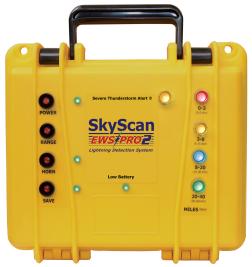How to Prepare Construction Sites for a Thunderstorm

Commercial Grade Lightning Detector
Therefore, it is important to stormproof your construction site with a Lightning Detector during thunderstorm season. This means having the right equipment available and ensuring all site personnel acquire the proper storm knowledge and training ie: a Lightning Plan. Continue reading for 4 tips on how to prepare your construction site for a thunderstorm.
Tip 1. Use a Good quality Lightning Detector
Thunderstorms are notorious for the numerous lightning strikes. In fact, it is an astounding estimate that 24,000 people are killed by lightning strikes around the world each year, with an additional 240,000 more injured. Because your risk of exposure increases in an open environments, such as a construction site, protecting all site personnel from lightning strikes should be the number one priority.
With a professional grade lightning detector, such as this EWS-PRO-2 Lightning Detector from SkyScanUSA.com, you can stay instantly informed about the dangers of approaching thunderstorms. The EWS PRO2 features special identification software to filter out harmless cloud lightning activities from harmful ones that can reach the ground. This allows you to maximize your working times and minimize your losses as the detector will only ALERT when real dangerous lightning is within range.
Tip 2. Perform Daily Maintenance and Cleanups
The high wind speeds that occur during a thunderstorm have enough power to pick up stray materials and toss them around. Construction sites are especially vulnerable to these high winds due to the number of stray materials lying around. These materials can be anything from piles of dirt for earthwork projects to timber and steel for building projects.
This is why it is a good idea to perform daily clean-up activities in and around the construction site. This means picking up materials that are not in use and bundling or covering them up to ensure they will not get blown around during a thunderstorm. Once a storm hits, you will have little time to think about and coordinate these activities so it is best to do them when the sky is clear.
Tip 3. Train All Personnel on Storm Safety
When thunderstorms strike, everyone working outside is at risk. These risks can be minimized with the proper storm training which can help workers become informed about what to do during a storm.
These storm safety tips will teach your construction workers how to find safe shelter and what the proper evacuation procedures are when a thunderstorm arrives. You can also provide training sessions on the basics of how lightning detectors work so they can know when to evacuate the area.
Tip 4. Know What to do After a Strike
No matter how prepared you are for a lightning strike, you can never be sure that everyone will stay 100% safe. This can be due to uneducated workers not following the correct safety procedures or forgetting their thunderstorm safety training altogether. You can assert control in these situations by educating yourself on what to do in the odd chance that someone is hit by a lightning strike.
Obviously, all cases of lightning strikes will require professional help, so you must call emergency services at the first sign of trouble. As you wait for the ambulance to arrive, it is a good idea to start basic medical procedures such as CPR to minimize the damages. This also means you should have basic first aid kits on the construction site at all times.
